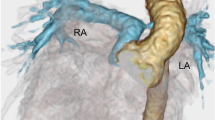Summary
Sixteen patients (10 males and six females) aged 7 months to 20 years, who had undergone surgical repair in the first year of life for total anomalous pulmonary venous connection (TAPVC), underwent assessment of cardiac rhythm by 24-h electrocardiogram (ECG) monitoring, nine of them also had maximal exercise treadmill tests, 3 months to 19.5 years after surgical repair. No patient had symptoms of an arrhythmia and the resting ECG was normal in all except one who had occasional single supraventricular ectopic beats. But on 24-h ECG monitoring significant arrhythmias were recorded in six of the 16 patients, including supraventricular tachycardia (three patients), bradyarrhythmia (two patients), sick sinus syndrome (two patients), and multiform supraventricular and ventricular ectopic beats (two patients). Five of these six patients were assessed more than 6 years after surgery. An inappropriate chronotropic response was seen on maximal exercise treadmill testing in four patients; three of them had arrhythmias previously recorded by 24-h ECG monitoring.
Our observations show that significant arrhythmias may occur in asymptomatic patients long after TAPVC correction, and we therefore recommend long-term follow-up of these patients, even if they are asymptomatic.
Similar content being viewed by others
References
Byrem CJ, Dick M, Behrendt DM, Rosenthal A (1982) Repair of total anomalous pulmonary venous connection in patients younger than 6 months old. Late postoperative hemodynamic and electrophysiologic status.Circulation 66:208–214
Clark EB, Kuglar JD (1982) Preoperative secundum atrial septal defect with coexisting sinus node and atrioventricular node dysfunction.Circulation 65:976–980
Cumming GR, Everatt D, Hastman L (1978) Bruce treadmill test in children. Normal values in a clinic population.Am J Cardiol 41:69–75
Davis JT, Ehrlich R, Hennessey JR, Levine M, Morgan RJ, Bharati S, Lev M (1986) Long-term follow-up of cardiac rhythm in repaired total anomalous pulmonary venous drainage.Thorac Cardiovasc Surg 34:172–175
Forfang K, Simonsen S, Andersen A, Efskind L (1977) Atrial septal defect of secundum type in the middle-aged: Clinical results of surgery and correlations between symptoms and hemodynamics.Am Heart J 94:44–54
Hesslein PS, Gutgessel HP, Gillette PC, McNamara DG (1982) Exercise assessment of sinoatrial node function following the Mustard operation.Am Heart J 103:351–357
Ruschhaupt DG, Khoury L, Thilenius OG, Replogle RL, Arcilla RA (1984) Electrophysiologic abnormalities of children with ostium secundum atrial septal defect.Am J Cardiol 53:1643–1647
Southall DP, Johnston F, Shinebourne EA, Johnston PGB (1981) 24-hour electrocardiographic study of heart rate and rhythm patterns in population of healthy children.Br Heart J 45:281–291
Young D (1973) Later results of closure of secundum atrial septal defect in children.Am J Cardiol 31:14–22
Author information
Authors and Affiliations
Rights and permissions
About this article
Cite this article
Saxena, A., Fong, L.V., Lamb, R.K. et al. Cardiac arrhythmias after surgical correction of total anomalous pulmonary venous connection: Late follow-up. Pediatr Cardiol 12, 89–91 (1991). https://doi.org/10.1007/BF02238409
Issue Date:
DOI: https://doi.org/10.1007/BF02238409




